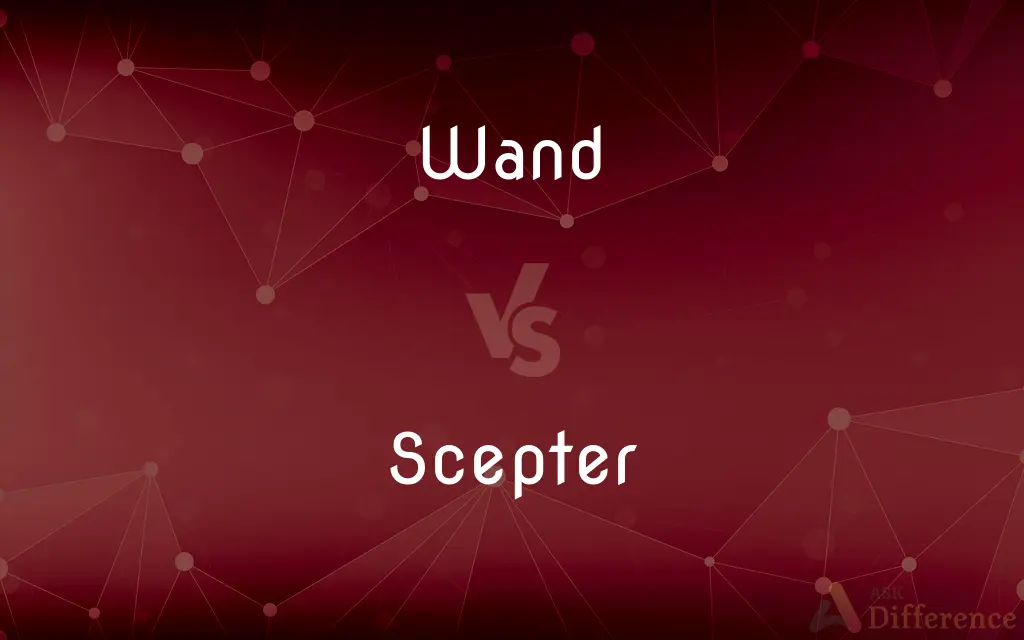Wand vs. Scepter — What's the Difference?
By Fiza Rafique & Urooj Arif — Updated on March 18, 2024
A wand is a thin, lightweight rod believed to channel magical power, while a scepter is a ceremonial staff symbolizing authority or sovereignty.

Difference Between Wand and Scepter
Table of Contents
ADVERTISEMENT
Key Differences
Wands are often depicted as tools of magic users, serving as a conduit for channeling magical energies and casting spells. They are typically made from materials like wood, bone, or metal and can vary in length, but they are generally slender and easy to wield with one hand. In contrast, scepters are heavier, more ornate staffs that represent power and governance. Made from precious metals and adorned with jewels, scepters are symbols of authority held by monarchs and deities in various cultures.
While the primary purpose of a wand is to amplify or direct magical power, making it a key element in the practice of witchcraft and wizardry, the scepter's role is largely symbolic, used in ceremonial contexts to denote the holder's ruling status or divine endorsement. This distinction highlights the functional difference between the two: wands are practical tools in magical practices, whereas scepters are objects of state and ceremony.
The origins of wands can be traced back to ancient practices and folklore, where they were believed to have the power to influence the natural world, heal, or protect. Scepters, on the other hand, have a storied history in royal regalia, serving as a visible emblem of the authority to rule and make laws. The design of a scepter, often topped with a symbolic ornament such as a globe, eagle, or cross, reinforces its role as a symbol of power and jurisdiction.
In literature and popular culture, wands are prominently featured in fantasy and mythology, associated with characters like wizards, witches, and fairy godmothers. Scepters, while also present in these genres, are more commonly associated with historical or epic narratives, symbolizing the power of kings, queens, and gods. This reflects their respective associations with magic and governance in storytelling.
Despite their differences, both wands and scepters share a commonality in representing forms of power, whether it be mystical or sovereign. Their significance extends beyond their physical form, embodying the themes of control, influence, and authority in various cultural contexts.
ADVERTISEMENT
Comparison Chart
Primary Use
Channeling magical power
Symbolizing authority or sovereignty
Material
Wood, bone, metal
Precious metals, jewels
Context
Magic, witchcraft
Ceremonial, regal
Symbolism
Magical abilities, influence
Power, governance
Historical Use
Ancient practices, folklore
Royal regalia, symbols of authority
In Literature
Fantasy, mythology
Historical, epic narratives
Design Features
Slender, lightweight
Heavier, ornate, often topped with an ornament
Compare with Definitions
Wand
Used by practitioners of magic.
Witches often choose wands made of specific woods for their spells.
Scepter
Represents sovereign power.
In ancient ceremonies, rulers were presented with a scepter as a sign of their authority.
Wand
Featured in fantasy literature and films.
The young witch received her first wand upon entering the magical academy.
Scepter
A ceremonial staff symbolizing authority.
The queen held her scepter aloft during the coronation.
Wand
Symbol of magical influence.
In stories, a fairy godmother uses her wand to grant wishes.
Scepter
Made from precious materials.
The royal scepter was adorned with gold and diamonds.
Wand
A slender rod believed to channel magical energy.
The wizard raised his wand to cast a spell.
Scepter
Associated with deities and royalty in art and literature.
The god was often depicted holding a scepter, denoting his dominion over the heavens.
Wand
Varies in material and design.
His wand, carved from an ancient oak, was a powerful magical tool.
Scepter
Often topped with a significant ornament.
The scepter’s globe symbolized the monarch's world-spanning authority.
Wand
A wand is a thin, light-weight rod that is held with one hand, and is traditionally made of wood, but may also be made of other materials, such as metal or plastic. Long versions of wands are often styled in forms of staves or sceptres, which could have large ornamentation on the top.
Scepter
A staff held by a sovereign as an emblem of authority.
Wand
A thin supple rod, twig, or stick.
Scepter
Ruling power or authority; sovereignty.
Wand
A slender rod carried as a symbol of office in a procession; a scepter.
Scepter
To invest with royal authority.
Wand
(Music) A conductor's baton.
Scepter
Alternative form of sceptre
Wand
A stick or baton used by a magician, conjurer, or diviner.
Scepter
Alternative form of sceptre
Wand
A stick or baton associated with the supernatural as a source of power.
Scepter
A staff or baton borne by a sovereign, as a ceremonial badge or emblem of authority; a royal mace.
And the king held out Esther the golden scepter that was in his hand.
Wand
A pipelike attachment that lengthens the handle of a device or tool
A vacuum cleaner that has two extension wands.
Scepter
Hence, royal or imperial power or authority; sovereignty; as, to assume the scepter.
The scepter shall not depart from Judah, nor a lawgiver from between his feet, until Shiloh come.
Wand
A handheld electronic device, often shaped like a rod, that is used for security purposes to detect metal.
Scepter
To endow with the scepter, or emblem of authority; to invest with royal authority.
To Britain's queen the sceptered suppliant bends.
Wand
(Sports) A narrow slat used as an archery target.
Scepter
The imperial authority symbolized by a scepter
Wand
To scan (a person, for example) with an electronic wand.
Scepter
A ceremonial or emblematic staff
Wand
A hand-held narrow rod, usually used for pointing or instructing, or as a traditional emblem of authority.
Wand
(by extension) An instrument shaped like a wand, such as a curling wand.
Wand
A stick or rod used by a magician (a magic wand), conjurer or diviner (divining rod).
Wand
A stick, branch, or stalk, especially of willow.
Wand
A card of a particular suit of the minor arcana in tarot, the wands.
Wand
(transitive) To scan (e.g. a passenger at an airport) with a metal detector.
Wand
A small stick; a rod; a verge.
With good smart blows of a wand on his back.
Wand
A staff of authority.
Though he had both spurs and wand, they seemed rather marks of sovereignty than instruments of punishment.
Wand
A rod used by conjurers, diviners, magicians, etc.
Picus bore a buckler in his hand;His other waved a long divining wand.
Wand
A baton used by a magician or water diviner
Wand
A ceremonial or emblematic staff
Common Curiosities
What is the purpose of a wand?
A wand is primarily used for channeling magical power and casting spells in practices of witchcraft and wizardry.
Can anyone use a wand or scepter?
In folklore and fantasy, wands can be used by those with magical abilities, while scepters are typically held by monarchs or deities as symbols of their authority.
Are wands and scepters interchangeable?
No, wands and scepters serve different purposes and are not interchangeable. Wands are practical tools for magic, while scepters are symbols of authority.
What does a scepter symbolize?
A scepter symbolizes authority and sovereignty, serving as a ceremonial object that represents the power to govern.
Can the material of a wand affect its magical properties?
In many stories, the material of a wand can influence its affinity for certain types of magic or its compatibility with the wielder.
Are scepters still used today?
Scepters are used in modern ceremonial events, particularly in contexts related to monarchy and certain religious rituals, maintaining their symbolic role.
How do the designs of wands and scepters differ?
Wands are generally slender and lightweight, designed for ease of use in magical practices. Scepters are heavier, more ornate, and often topped with a symbolic ornament.
How are wands and scepters made?
Wands are made from materials such as wood, bone, or metal and can vary in design. Scepters are crafted from precious metals and jewels and are often more ornate.
What roles do wands and scepters play in literature?
Wands are commonly featured in fantasy and mythology, associated with magic. Scepters appear in historical or epic narratives, symbolizing regal or divine power.
Do wands and scepters have historical origins?
Both wands and scepters have roots in ancient practices and symbolism. Wands were used in magical rituals, while scepters have been part of royal regalia and symbols of authority for centuries.
Share Your Discovery

Previous Comparison
Fox vs. Human
Next Comparison
Failure vs. CollapseAuthor Spotlight
Written by
Fiza RafiqueFiza Rafique is a skilled content writer at AskDifference.com, where she meticulously refines and enhances written pieces. Drawing from her vast editorial expertise, Fiza ensures clarity, accuracy, and precision in every article. Passionate about language, she continually seeks to elevate the quality of content for readers worldwide.
Co-written by
Urooj ArifUrooj is a skilled content writer at Ask Difference, known for her exceptional ability to simplify complex topics into engaging and informative content. With a passion for research and a flair for clear, concise writing, she consistently delivers articles that resonate with our diverse audience.














































